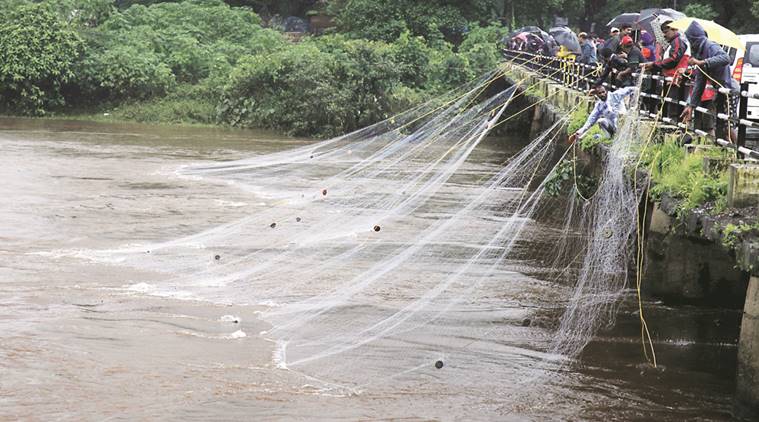Stay updated with the latest - Click here to follow us on Instagram
Mahad bridge collapse: Rescue hit by rain, eight more bodies found
A total of 42 people were reported as washed away along with part of a bridge in Mahad on the Mumbai-Goa Highway on Tuesday night
 The NDRF, along with local residents, spread fishing nets close to the bridge in the hope of recovering bodies. (Express Photo by Narendra Vaskar)
The NDRF, along with local residents, spread fishing nets close to the bridge in the hope of recovering bodies. (Express Photo by Narendra Vaskar)
Bodies of eight more drowned passengers were recovered from the swollen Savitri river on Friday, even as rescue operations were severely curtailed by heavy rain. Addressing the families gathered at the makeshift control room near the collapsed bridge at Mahad, Raigad District Collector Sheetal Teli-Ugale said that helicopters of the Indian Navy and Coast Guard could not fly due to bad weather.
“Search operations are difficult today because the water is very deep and current strong,” she said on Friday afternoon.
Two white boards placed on either side of a large table at which Teli-Ugale sat, showed the names of the dead and the missing. She added, “We understand your anxiety, but please cooperate with us. Today, the depth of the river is 5.10 metres and yesterday it was 3.5 meters. You know there are crocodiles in the water. Bodies of the deceased are being found and identified,” she said.
Among those identified on Friday were 49-year-old Ajay Gurav of Rajapur and Ratnagiri-based couple Vijay (48) and Vijaya (40) Pandit. The last body to be recovered on Friday afternoon was that of 18-year-old Mahendra Kamble, a native of Chiplun. An official from the Mahad Tehsildar’s office said that Mahendra was on the ill-fated Jaigad-Mumbai bus, which his father Shrikant Kamble was driving. The older Kamble’s body was found on Thursday. “Mahendra had secured 96% marks in his HSC exams and was travelling to Mumbai to appear for a college interview,” the officer said.
Until 5 pm, Mahad had received 87 millimeter of rain, and Mahabaleshwar 117 mm. “We couldn’t search close to the incident site and extended to a stretch between 15 and 30 kilometers. But we had to stop at 4 pm due to the rain,” said Anupam, Commandant, 5th Battalion, NDRF.
The NDRF, along with locals, spread fishing nets in the water close to the bridges in the hope of recovering a few bodies. “We also used fish finders, which detect fish using sonar. The finders show the depth of the water but the terrain here is so hilly and there are so many boulders in the river that they weren’t very effective,” he added.
A total of 42 people were reported as washed away along with part of a bridge in Mahad on the Mumbai-Goa Highway on Tuesday night. Two state transport buses taking 22 passengers to Mumbai and nine people inside a Chevrolet Tavera car are confirmed as having plunged into the water. The number of other vehicles that plunged into the river is still unclear, the police said.
Authorities at the Mahad Government Rural Hospital fear about the condition in which the the bodies may be discovered, the longer the search operations continue. “The last few bodies have been found more than 50 hours after the accident. The first thing that happens when human bodies stay so long in water is muscles begin to decompose. Gases begin to form and bodies being to swell,” said Dr. Mahesh Mehta, Senior Medical Officer at the Sub District Hospital in Shrivardhan, who has been called in specially to supervise medical operations.
Identification has so far proved relatively easy, as decomposition has not completely distorted physical features. “Relatives are able to make out faces of the dead. Men are being identified on basis of tattoos and identity cards, railway passes and bus slips,” Dr Mehta said.
Women, Dr Mehta said, are being distinguished by their clothes and jewellery. Medical officials say that the bodies indicate the struggle of passengers to escape.
“The fingers are half clenched and frozen in the action of scratching at some surface. There is also mud underneath the fingernails. Tongues are stuck out and passengers look clearly like they have choked,” said Dr Bhaskar Jagtap, Medical Superintendent, Mahad Government Rural Hospital.
Dr Mehta added that maggots had been found inside the bodies, and a snake was found on clothes of passengers.
At the hospital, five specialist doctors have been posted from across the district to support the three doctors posted there. “We have also got 15 para-medical officers and 46 ambulances. 26 of these are air conditioned ambulances in which we have ensured that the temperature is between 18 and 20 degrees Celsius while transporting bodies,” Dr Mehta said. The hospital is equipped only to conduct four post-mortem examinations. Dr Mehta said a ward was being converted into an additional post-mortem center.
Watch Video: What’s making news
Each post-mortem is being video recorded to ensure that families encounter no trouble in processing insurance claims.
To expedite autopsies, ambulances have also been stationed for some 100 kilometres along the river bank. “We are considering posting doctors in ambulances on the field and having them conduct post-mortems on the spot so bodies can be handed over as soon as possible,” Dr Mehta said.
“There is no mortuary at this hospital,” Dr Mehta admitted, adding, “There has just not been any need for it here until now. We have decided to send any unidentified bodies to J J Hospital if no next of kin come forward.”
Uninterrupted post-mortems for three days at the small center is beginning to take its toll on medical officials. “We have been exposed to the smelling bodies for three days,” Dr Mehta said.







